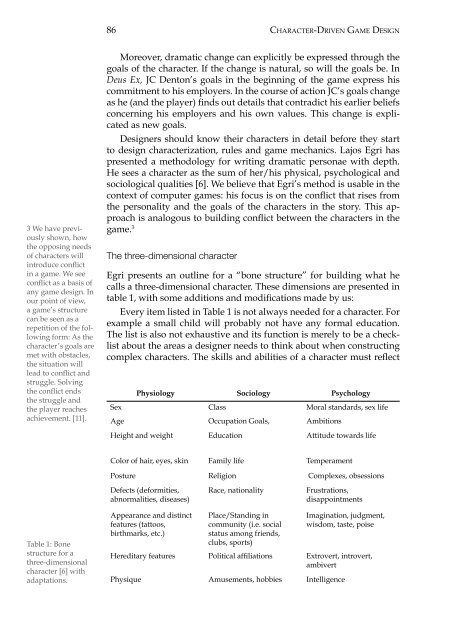Character Driven Game Design
Character Driven Game Design
Character Driven Game Design
Create successful ePaper yourself
Turn your PDF publications into a flip-book with our unique Google optimized e-Paper software.
86<br />
<strong>Character</strong>-<strong>Driven</strong> <strong>Game</strong> <strong>Design</strong><br />
3 We have previously<br />
shown, how<br />
the opposing needs<br />
of characters will<br />
introduce conflict<br />
in a game. We see<br />
conflict as a basis of<br />
any game design. In<br />
our point of view,<br />
a game’s structure<br />
can be seen as a<br />
repetition of the following<br />
form: As the<br />
character’s goals are<br />
met with obstacles,<br />
the situation will<br />
lead to conflict and<br />
struggle. Solving<br />
the conflict ends<br />
the struggle and<br />
the player reaches<br />
achievement. [11].<br />
Moreover, dramatic change can explicitly be expressed through the<br />
goals of the character. If the change is natural, so will the goals be. In<br />
Deus Ex, JC Denton’s goals in the beginning of the game express his<br />
commitment to his employers. In the course of action JC’s goals change<br />
as he (and the player) finds out details that contradict his earlier beliefs<br />
concerning his employers and his own values. This change is explicated<br />
as new goals.<br />
<strong>Design</strong>ers should know their characters in detail before they start<br />
to design characterization, rules and game mechanics. Lajos Egri has<br />
presented a methodology for writing dramatic personae with depth.<br />
He sees a character as the sum of her/his physical, psychological and<br />
sociological qualities [6]. We believe that Egri’s method is usable in the<br />
context of computer games: his focus is on the conflict that rises from<br />
the personality and the goals of the characters in the story. This approach<br />
is analogous to building conflict between the characters in the<br />
game. 3<br />
The three-dimensional character<br />
Egri presents an outline for a “bone structure” for building what he<br />
calls a three-dimensional character. These dimensions are presented in<br />
table 1, with some additions and modifications made by us:<br />
Every item listed in Table 1 is not always needed for a character. For<br />
example a small child will probably not have any formal education.<br />
The list is also not exhaustive and its function is merely to be a checklist<br />
about the areas a designer needs to think about when constructing<br />
complex characters. The skills and abilities of a character must reflect<br />
Physiology Sociology Psychology<br />
Sex Class Moral standards, sex life<br />
Age Occupation Goals, Ambitions<br />
Height and weight Education Attitude towards life<br />
Color of hair, eyes, skin Family life Temperament<br />
Posture Religion Complexes, obsessions<br />
Defects (deformities,<br />
abnormalities, diseases)<br />
Race, nationality<br />
Frustrations,<br />
disappointments<br />
Table 1: Bone<br />
structure for a<br />
three-dimensional<br />
character [6] with<br />
adaptations.<br />
Appearance and distinct<br />
features (tattoos,<br />
birthmarks, etc.)<br />
Place/Standing in<br />
community (i.e. social<br />
status among friends,<br />
clubs, sports)<br />
Imagination, judgment,<br />
wisdom, taste, poise<br />
Hereditary features Political affiliations Extrovert, introvert,<br />
ambivert<br />
Physique Amusements, hobbies Intelligence
















